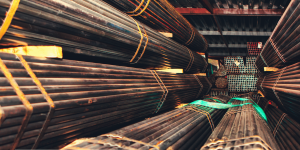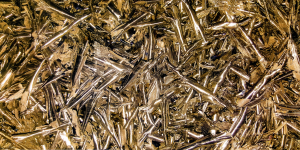Introduction
Metals are versatile materials used to construct structures, vehicles, electronics, and medical equipment. Based on their properties, metals can be classified into two major groups, namely Ferrous and Non-Ferrous. This paper aims to compare these two types of metals as far as their characters, functions, benefits, and drawbacks are concerned.
What are Ferrous Metals?
Ferrous metals have iron as the main component of the metal.

Some common ferrous metals include:
– Steel: Steel is an alloy created by the combination of iron and carbon, for the most part. Other ingredients such as chromium, nickel, and manganese are also added proportionally to get different steel qualities. Steel is challenging and is used more than any other metal in the world.
– Cast iron: Cast iron is iron with more than 2% of carbon. It provides good compressive strength but has low tensile strength.
– Wrought iron: This is very close to pure iron with very low percentages of carbon in it. Wrought iron is easily forged and can be rolled or hammered into various shapes besides being resistant to rust.
– Alloy steels: Additions of small amounts of elements such as aluminium, vanadium, and cobalt are made to iron to produce alloy steels superior to steel in specific characteristics.
Properties of Ferrous Metals
– Strength: Ferrous metals are often solid and slightly rigid in comparison to non-ferrous materials, which provide good tensile and compressive strengths. It depends on the specific alloying and heat treatment processes used to fabricate their strength.
– Durability: Ferrous metals are generally strong in their resistance to wear and pressure. But they can rust if exposed to moisture for some time. Some care is necessary to avoid rusting of the materials used in the construction of the appliances.
– Magnetic: All ferrous metals show magnetic character highly. This makes them useful in motors, generators, transformers, etc.
What are Non-Ferrous Metals?
Non-ferrous metals are those that do not contain any iron content or have very little of it. They are used both in the form of pure metals and in the form of alloys.
Some common non-ferrous metals include:
– Aluminium: The material is characterized by a low density and high corrosion resistance. Said to be used in aircraft, utensils, etc.
– Copper: Copper has good electrical and thermal conductivity, making it suitable for wiring and heat exchangers.
– Zinc: Show an excellent resistance to corrosion and mechanical characteristics. Employed in treating iron and steel to make them less susceptible to rusting.
– Other non-ferrous metals include lead, tin, and nickel.
Properties of Non-Ferrous Metals
– Lightweight: Non-ferrous are generally lighter than ferrous metals Due to their characteristics and uses, which are different from ferrous metals. This makes them suitable for applications that are targeted towards weight loss.
– Conductivity: Some non-ferrous metals such as copper, aluminium and brass possess relatively enhanced electrical and thermal conductivity.
– Corrosion resistance: Aluminium and zinc, for instance, have reasonable corrosion resistance due to passivation. This reduces maintenance costs.
– Non-magnetic: All non-ferrous metals are non-magnets and, therefore, can be used in contexts where magnetic properties are not wanted.

Comparing the Properties
Strength and Durability
Let’s take an example of ferrous and non-ferrous metals; ferrous metals are stronger and more rigid than non-ferrous metals. Alloy steels possess very high strength, up to more than 2000 MPa. However, most non-ferrous alloys have a maximum strength of a mere 1000 MPa. Ferrous metals also have good strength at high temperatures and are not quickly melted.
Weight
Non-ferrous metals are nearly always lighter than ferrous metals. For instance, aluminium has a density of only one-third that of steel. One of the most practiced weight reduction methods is the replacement of ferrous parts with non-ferrous materials.
Conductivity
Compared to ferrous ones, non-ferrous metals excel in both electrical and thermal conductivity. Namely, metals like copper and aluminium are used where conductivity is especially desirable. Ferrous metals, on average, are known to have conductivities that are 100 to 1000 times less.
Magnetic Permeability
All ferrous metals are magnetic and have magnetic relative permeabilities much higher than one. Non-ferrous metals exhibit permeability close to 1, implying that these metals are not attracted to magnets.
Corrosion Resistance
Organic materials are also less susceptible to corrosion since non-ferrous metals are nobler than iron or steel. Ferrous metals are vulnerable to moisture and require protection by a covering in order not to rust. Aluminium, zinc, and copper form an oxide skin that does not let further corrosion occur.
Uses of Ferrous Metals
– In constructing buildings, ships, vehicles, machinery, etc., because of its strength, which is beyond competition.
– Hardware and kitchen utensils such as knives, forks, spoons, and refrigerators, among other appliances, because of their resistance to rusting.
– In gears, shafts, sheets, tools, etc., mechanical parts are made from cast iron and carbon steel.
– The steels used in critical parts like blades of the turbines, aircraft structures, etc.
– Copper in electrical wiring, plumbing, statues, and other items for its natural copper look.
Uses of Non-ferrous Metals
– Aluminium in aircraft parts, foils utensils, and many other uses due to its lightness and corrosion resistance
– Copper wiring in electrical equipment because of its high conductivity. It is also applied in heat exchangers.
– Zinc is used for coating iron to protect it from rusting and for combining copper to form brass and tin to create bronze.
– Leading in radiation shielding applications due to high density.
– Other metals such as gold, silver and platinum have uses in jewellery and electronics.
Conclusion
While ferrous and non-ferrous metals are used in our daily lives because of their unique properties. On the one hand, ferrous metals perform better in terms of hardness, stiffness, and cost, but non-ferrous metals are used in those applications where factors such as lightness, electrical conductivity, and resistance to corrosion are more critical. It depends with the application in question and the demand that comes with it. The fact that these two groups do not share a standard set of characteristics also means that they are perfectly harmonious in terms of functionality.
